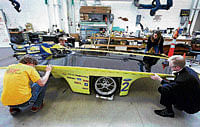Taking off the pounds from cars to chase a sun-powered victory

Just a few days ago, the newest and best hope in American solar car racing improbably rested atop four laundry baskets. Quantum, the newest creation of the University of Michigan’s solar car team, was designed for the World Solar Challenge in October. If it wins that event, in Australia, it would be the first victory for an American entry since General Motors’ Sunraycer in 1987.
But Quantum would go nowhere until its 16-inch aluminum wheels were delivered to the Wilson Student Team Project Center on the university’s north campus. So for the time being, the laundry baskets, flipped upside down and reinforced with bright yellow tape, supported its carbon-fiber chassis. The structure weighed just 52 pounds even when outfitted with suspension components, disc brakes and custom-made rack-and-pinion steering gear.
The target weight for the fully assembled Quantum — the 11th car in the 22 years of the Michigan solar team’s existence — was just 320 pounds.
“I’m really pleased to hear that they’ve gone back to pushing the weight down to the minimum,” said Robert P Larsen, an early proponent of solar car competitions who is a senior technical adviser at the Center for Transportation Research of the Argonne National Laboratory. “The U of M cars always had the reputation for being very well done, and they also brought a lot of resources to the table that other teams never had. But they tended to be on the massive side.”
Except for its compact dimensions, the chassis strongly resembles the hull of a hydroplane that might compete for the Gold Cup some 50 miles away in the Detroit River.
Tight cockpit
The driver must squirm into the tight cockpit and, after the waferlike carbon-fiber deck — with its array of solar cells — is placed overhead, endure temperatures of up to 120 degrees. The only air-conditioning comes from an open duct bringing outside air. A surprising amenity, though, is cruise control. It can even be set remotely, using an iPhone.
The cockpit canopy shared the same maize-and-blue winged motif as a defensive tackle’s helmet on the Michigan gridiron. The car and the football player would just about balance each other on the scales, too.
The svelte Quantum succeeds the 500-pound Infinium, winner of the 2010 North American Solar Challenge — Michigan’s dominating sixth title in the event. (Michigan’s entries traditionally take names ending in the letters “um,” to match the school’s initials.) Last summer’s race covered 1,100 miles from Oklahoma to Illinois, with competing cars running in real-world traffic.
“The name Quantum is appropriate because it makes you think of something very small and precise, and that’s what we had to do to be the best in the world,” said the project manager, Rachel Kramer, a junior neuroscience major from Ludington, Mich. “We have to refine and optimise every single system on the car.”
To lighten Quantum, aluminum and titanium — which were not necessarily chosen for their final syllable — were used extensively, in addition to the carbon-fiber body.
Making aerodynamic advances has been of foremost importance. Created with help from more than 300 sponsoring firms including General Motors, Roush Industries and a number of precision machining companies, Quantum is “one of the most aerodynamic vehicles anywhere,” said the business and operations director, Chris Hilger, a senior chemical engineering major from Northville, Mich.
Aerodynamic design was refined with help from the Exa Corporation. “They have software that’s incredibly powerful, and we couldn’t have that kind of precision with any software that we had available,” said Kramer, who manages the team’s $1.2 million budget, which covers the car’s two-year production cycle.
The 16-foot-long Quantum stretches about 10 inches beyond the length of an original 1965 Ford Mustang. And it’s just 37 inches tall, so the original neck-bending Lamborghini Countach would tower over it.
A veteran of Michigan’s third-place effort in the 2009 World Solar Challenge, Hilger remembers smooth roads in the 3,000 kilometers across central Australia, from Darwin in the north to Adelaide in the south. But he said the Quantum’s lightweight front suspension, and the beautifully machined aluminum fork that supports the rear wheel, are most likely up to the challenge posed by cattle grates, the course’s roughest points.
Usage of solar panels
Electricity produced by the solar panels and stored in a pack of lithium-ion batteries is used to power the small direct current motor mounted at the rear hub.
Although the unit produces no more than three horsepower, Quantum will race at 60 miles per hour. Hilger said the previous car, Infinium, once was tested at 105 mph.
Michigan’s 20-member Australia team will include a meteorologist whose forecasts, made possible by a satellite link, will predict cloud cover and help the crew chief to develop strategies for power supply management. One thing that can’t be predicted: dust storms lasting a day and a half, which Hilger experienced in 2009.
A tractor-trailer rig will support the team, carrying two spares of every component of the car. It’s also a mobile workshop, equipped with a mill and a lathe. “We can machine something in the middle of the Outback,” Hilger said. The toughest competition is expected to come from the defending champion Tokai University team of Japan, and the latest entry by Delft University of Technology of the Netherlands.
Quantum’s shakedown run comes May 2-7 in the Formula Sun Grand Prix at the Indianapolis Motor Speedway, but Kramer downplayed expectations for the new car.